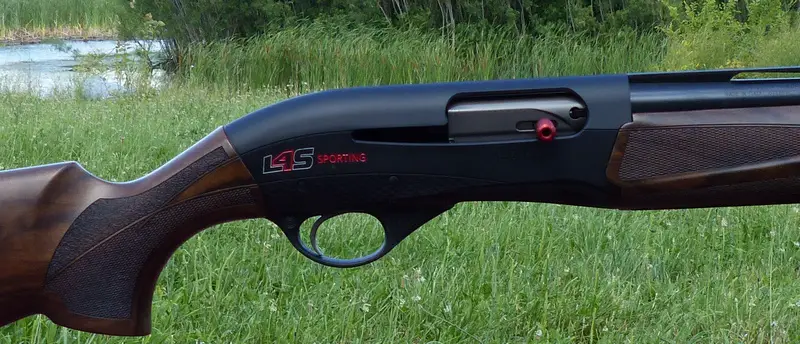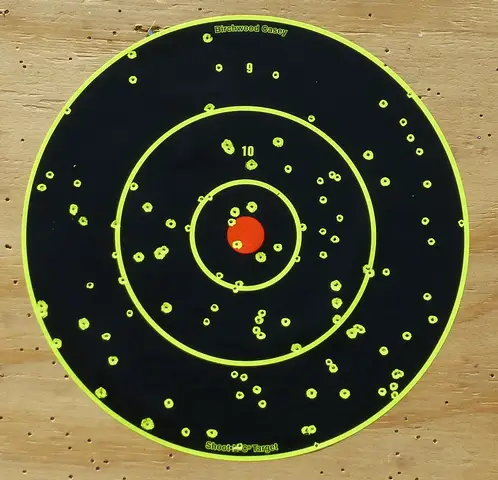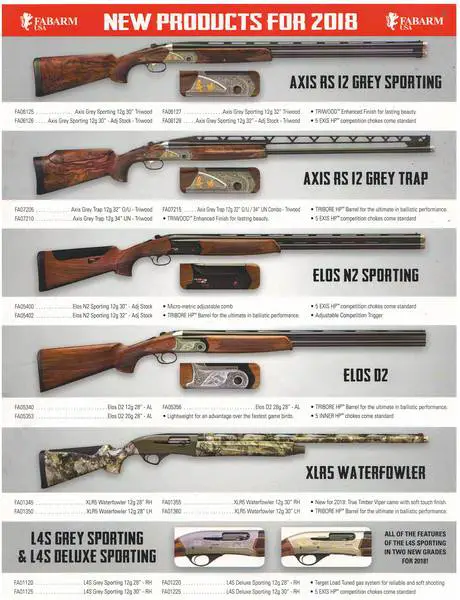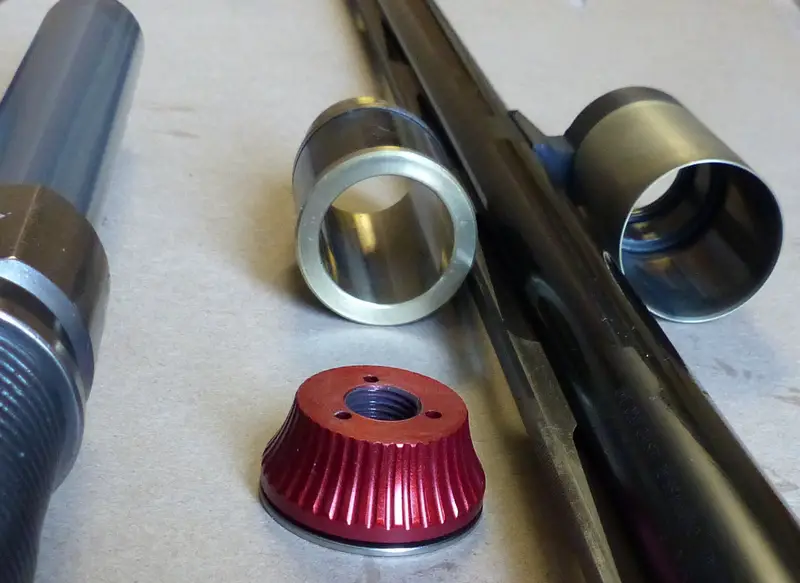Is the Fabarm L4S Sporting the Best Clays Shotgun on the Market?

The first time I ever shot a shotgun in casual competition was a turkey shoot. It was trapshooting, not card-shooting, and the gun I used was a miserable High Standard Supermatic Trophy. It was a single shot more often than not, but that's all that was needed at the time. It fit me well and the winner got a turkey, second place got the bacon. It was memorable for me, not so much for winning that turkey, but because my Great-Grandfather was still around, and Great-Grandpa got a kick out of it. Aside from making Great-Grandpa proud, it did take a lot of wild pheasants. The first shot had to count, for more often than not, the Supermatic Trophy was a self-loader only in the theoretical sense. When it is all you have though, it is appreciated for throwing rocks at wild roosters doesn't work particularly well.
Way back when, I shot my first 100 straight in trap with an old Remington standardweight 20 gauge 870 Wingmaster with a fixed Improved Cylinder choke. It wasn't perfectly ideal for the task back then and it isn't today. Skeet came along much later and it was a Browning 425 that I was first able to run the field with. Still, I generally did better with an old Belgium Automatic-Five Light Twelve than that 425 and the A-5 was more fun to shoot as well. At skeet, so was a Browning B-80 20 gauge for that matter. The first time I spent a thousand dollars for a shotgun, some thought I was crazy. When I spent two thousand dollars for a shotgun, some were convinced of it. $2000 in 1982 is about $5073 in 2017 dollars, so at the time it took some scrimping and saving.
Back then, I was curious about the mystery of the SxS and the O/U. Why I spent so much time and money fighting with them is about the only mystery left. I shot ill-fitting shotguns so much (Winchester 101) that I needed to have the scar tissue removed by an oral surgeon from inside my cheek. Sometimes, you need to tinkle on the electric fence and I was one of those guys. For high volume race-game shooting back then, along came steel receiver Browning B-80s, the related Beretta 303, and the Beretta 390 ST. Those guns didn't break.
Folks talk quite a bit about quality, but today that is something that many don't want to pay for. Browning never has offered autoloading shotguns as good as the A-5, or the Beretta-barreled B-80, and Beretta has never made an autoloader as well as they did with the 303 and the 390. Just like with bolt-action rifles, there seems to be a race to the bottom as far as quality of machining, quality of the assembly, and quality of finish. The shotguns that do the large numbers are cheap. Many of my neighbors spend more for two months of cable than they would for a new shotgun. There isn't much question what has lasting value, but many do not see it that way.
The Fabarm L4S is a breath of fresh air. My old Beretta 303's and 390s had chokes that liked to unscrew themselves, and the blow-by on most of my Mobil-choked and standard Invector (Win-choke) guns is often impressive: an impressive mess that is. My experience with Fabarm autoloaders is the exact opposite. After a few hundred rounds, you can remove the choke tubes and they don't show any crud between themselves and the barrel at all.
CHOKES

Often, the first order of business with a new shotgun is to buy good aftermarket choke tubes. Too often, factory-supplied choke tubes are the “highest quality at the lowest price from the cheapest vendor in the world,” made on worn-out tooling out of some kind of metal, somewhere, by someone. One of the reasons that choke designations (IC, MOD, FULL, etc.) do not and cannot mean anything is the shotgun barrels themselves. Shotgun barrels are usually struck, and the barrel inside diameters vary from barrel to barrel by .005 - .010 inch, or more. Your “Mod” choke may be an IC in performance, or a cylinder. You won't know unless you measure your barrel, for there is no constriction unless you know the bore diameter of the barrel itself and the exit diameter of the choke. Your factory choke tube often sucks because it has little to no actual constriction: no constriction, no choke.
Fabarm choke tubes are listed as 0/10, 1/10, and so forth up to 10/10. All 97mm Exis HP choke tubes are approved for use with steel shot shotshells. Fabarm choke tubes constrictions are in one-tenth of one millimeter, which is 0.0393701 inch. That's roughly .004 inch per stage of constriction. A 0/10 is cylinder (no constriction), a 1/10 is skeet, a 5/10 is about .020 inch (Modified) and a 9/10 is about .036 inch (Full). As with all choke tubes, the quality of the shell has a lot to do with pattern efficiency.
Fabarm Tri-Bore barrels are precision-drilled. What that means is the Fabarm Exis choke you have is going to throw the same pattern percentage as mine and, with the same ammo, will perform the same out of any other Fabarm Tri-Bore barrel.
Over-sized factory bores, sometimes incorrectly called “Back-Bored” barrels, invariably show velocity loss compared to standard bores. Fabarm Tri-Bore barrels do not, clocking 30-35 fps faster with the same shells compared to a Browning Maxus and similar. Is it enough to “really” matter? It isn't a huge difference, but there is a clear difference.
TRADITIONAL WEAK SPOTS
There are well-known, traditional weak links in autoloading shotgun designs. One is the mainspring and mainspring tube in the buttstock which is hard to monitor, easily fills with crud, and rusts. The L4S (and XLR5 models) eliminates those potential issues, by putting all the goodies (action spring and bars) forward of the receiver.
When you have a gas piston that relies on fragile springs to function, again the Browning / Winchester “Active Valve” system, your piston can fail. Clearly, they all do not, but when they do break it is invariably at the wrong time. Aftermarket modifications turn the Active valve into a solid piston, meaning it doesn't work, but some have gone that route anyway. Other gas pistons are somewhat fragile designs with ears that are prone to fracturing. It is enough of a problem that again, there are aftermarket pistons available. These issues are not present in the L4S Sporting.
QUALITY and THE SOLID FEEL
Many autoloaders have sloppy barrel extension to receiver fit. The barrels easily rotate back and forth with very little encouragement. Many autoloaders also have loose forearm syndrome. While it hardly means that they do not function, it does mean that they lack the confidence-inspiring solid, stable feel that you expect with a good O/U. The L4S has that feel, for the forearm (unlike most autoloaders) is not what holds the barrel on. The result is no unwanted forearm movement, no continual forearm loosening, no forearm stress, and the ability to give your gun a “90% clean” just by removing the forearm. You can fire the gun without the forearm on, for that matter, as it isn't a functional part of the action. If you do fire the L4S without the forearm and burn yourself . . . well, it is your fault and no, that's not recommended. Nevertheless, the forearm is not a stressed component and you won't feel the vibration through it that you might on other autoloaders.
LOAD INTENSITY
According to Fabarm USA, the L4S Sporting is designed for perfect function with 7/8 oz. 1200 fps loads on up. Personally, I have no use for loads that light, and with 1200 fps loads or similar, the L4S Sporting is like shooting a pillow. With 1-1/8 oz. 1230 fps loads, recoil is also not an issue whatsoever for me. The 28 inch L4S Sporting weighs 7-1/4 lbs., about half of a pound more than the L4S Hunter. With a gas gun, peak recoil force is cut by about a third vs. fixed breech guns. If you go with a 30 inch barreled L4S Sporter, that adds a couple of ounces, and if you wish, you can add the 150 gram (5.29 oz.) “Kinetik Recoil Reducer” to the buttstock in moments. I have not found that necessary at all, but some may wish to go that route and it screws right in. That gets you an unloaded gun weight of over 7-1/2 pounds effortlessly.
TRI-WOOD
In general, I prefer traditional walnut finishes. However, Tri-Wood is the best-looking of the enhanced finishes out there, it can be cut, and adjustable combs can be installed from Cole Gunsmithing if you desire. Jim Bellegarde at Cole Gunsmithing will install a 4-way adjustable comb for you, with Cole's own hardware for $325.
Tri-Wood is weatherproof and requires no regular care. The underlying walnut is straight-grained and a bit stronger than some heavily figured stocks, if only slightly. For 2018, Fabarm USA is adding two higher grade trim levels featuring oil-finished walnut: the Grey Sporting and the Deluxe Sporting. They should be available in June, so you can pick your trim level as your personal tastes dictate.

MODELS
The L4S Sporting is available in both right hand and left hand eject configurations. For 2018, the Syren L4S Sporting is being offered for the ladies, also in right hand and left hand eject models. As mentioned, 2018 also brings the L4S Sporting in Grey Sporter and Deluxe Sporter upscale models. 2018 MSRP for the standard L4S Sporting is $1895, it comes with a hard case, five choke tubes, and so forth. Individual dealers set their own actual street pricing, of course. The same stainless steel internal components, heavy chrome plating, and advanced PVD coatings are used throughout the line.
Note: Some have asked about the basic differences between the L4S Sporting and the L4S Initial Hunter. The L4S sporting about is about a half pound heavier gun with 30 and 32 inch barrel options, has Tri-Wood, a thicker recoil pad, a slightly different stock configuration, has an oversized charging handle and bolt release, comes with a hard case, comes with 5 extended chokes instead of three flush chokes, has a 2-3/4 inch chamber, has a solid gas piston tuned for target loads of 7/8 oz. 1200 fps and up. and so forth. If your primary use is breaking clays with perhaps some dove or pigeon shooting, the L4S Sporting is the choice. As a pheasant / upland hunting gun primarily, with some target work is what you are looking for, one of the L4S Hunter models likely suits that intended use a bit better.
FINALLY

Many folks have their own pet ways of cleaning their guns. As far as I'm concerned, Hornady One-Shot Firearm Cleaner and Lube is the best thing to happen to gas-operated shotguns in a very long time, and makes cleaning that is already extremely quick, even quicker, and doesn't allow for much build up.
The Fabarm L4S models shoot to point of aim at 40 yards, which is remarkable because so many shotguns do not. The only modification I made on the L4S Sporting is a very minor one. While I like the red accents, the red charging handle was a bit too much for me, so I popped in a black one. That's exactly every change I've made to my example.
Fabarm USA dealers are all over the country. There is an extensive listing on the Fabarm USA website. If you know what specific model you want, you can call Fabarm directly and they will be happy to help you locate it. I like Cole Gunsmithing, https://www.colegun.com/ and Kelly Field or Jim Bellegarde will be happy to help you. For custom work like 4-way or 6-way adjustable combs, or trigger work Jim Bellegarde is your premier source.
Cole, Inc. (North)
21 Bog Hollow Road
Harpswell,
ME 04079
207-833-5027
Rich Cole had a lot to do with the final development and configuration of this gun. Jim Bellegarde is one of the most experienced and respected shotgun smiths in the country and Jim personally has been shooting a Fabarm L4S hunter model for essentially everything since they were first released.
The Fabarm L4S Sporting is the most fun to shoot autoloading shotgun out there, which is the whole point. I like responsive, easy handling guns and the L4S is it. Though soft-shooting, perfect for clays, it is not ponderous at all, so you'll have a great time with it on the dove field as well. When you take one for a test drive, you'll be a believer as well.
Copyright 2018 by Randy Wakeman. All Rights Reserved.











